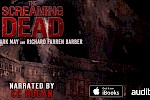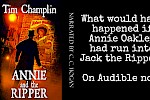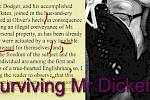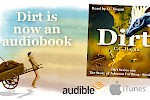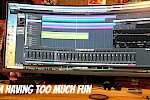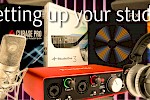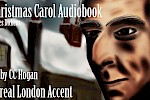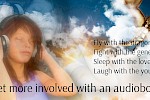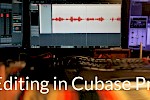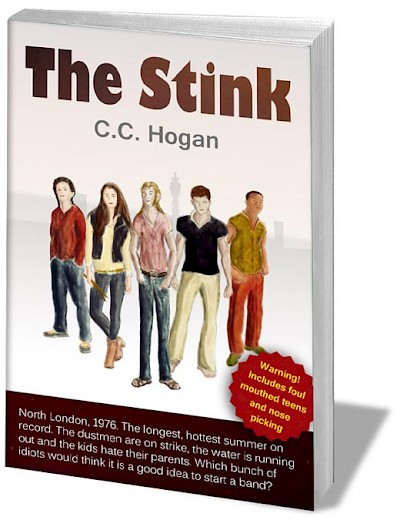Audiobook Menu
FAQs:
Reading Your Book
Recording Your Book
Editing Your Recording
Technical Questions
Recording your own poetry
Other Articles:
A General Guide
Recording Dirt
Recording My Poetry
Preparing Your Manuscript
Plan your audiobook as you write
Using iZotope RX 6 with Cubase
Editing in Cubase demonstration
A bit on Punch & Roll
Should you delete breaths?
Setting up your Studio
External Articles & Resources
Punch and Roll
Part of the series of tips on recording your book as an audiobook, this FAQ deals with technical issues such as sound booths, microphones, and other interesting bits and pieces
You should also look at reviews of microphones and equipment from other articles. All my experience has been with top-end gear which is out of most people's pockets, including mine these days!
What shape should my voice booth be?
Anything but square or rectangular! Two things are a problem in a booth - hard walls and reflections. If your walls are parallel, then sound can reflect back and forth, even through the acoustic foam. This will increase the "boxy" sound. So, make is nice and wonky!
What is Room Tone?
Room tone, or Buzz Track, is a recording of the room made with the mic placed in the position it will be used in and with the same settings as the main recording. Often room tone is recorded at the end of the session, just after the voice has finished recording. Room tone is used to fill in gaps in the edit so the overall record does not suddenly dip into an unnatural silence.
What can you do about Pops?
Pops are when a blast of air blows across the mic from the mouth, making a deep "pop" which is almost impossible to edit out. The two most obvious sinners are P and B on the front of a word, but Qu, for instance in Quiet, can also pop.
There are two ways to avoid them. One is to speak slightly off mic so that any air blast does not hit the mic capsule, and the second, better way is to learn to soften Ps and Bs. The way to do this is to make a Per sound while blowing out to create the worst pop possible. Then, slowly reduce the airflow while maintaining the P sound. By experimenting, you will work out how to Soften your Pees, as it is called.
What is a Gate?
A gate is a process that switches off the sound when it drops below a certain level. Most modern gates can be adjusted so the reduces the level rather than cut it off entirely. Gates are very useful to eliminate very low-level noise problems, but should never be used to reduce higher level noise issues - get rid of the nose instead. In an ideal world, avoid using a gate entirely, but you may not be able to in your home studio.
Should I "gate" my recording?
No. You may wish to use some gating when you mix down (see the editing section), but you should not gate during the record. Gating can cut off breaths if set up wrongly and cause other problems. If you gate during record, then you cannot solve these problems. If you have room noise problem so loud that you feel you have to use a gate, then sort the noise out instead!
What is a compressor?
A compressor is either a software or hardware processor that lowers the very high levels and pulls up the very low levels. The result is a narrower dynamic range that sounds louder because the average level is higher, even though the peaks are lower. Too much compression can make the voice recording sound too "pressured" and can make it quite ugly to listen to. Compression will also make breaths louder. Radio stations use a lot of compression on their music programming output, especially with chart shows, so that they cut through on small radios and car radios. Television and film, on the other hand, use less compression, as do audiobooks and talk radio stations like BBC Radio 4.
Should I "compress" my recording?
Yes, but not too much. Again, like gating at record, if you compress the input, you cannot then remove that compression later. However, a limited amount of compression and limiting, say at a ratio of 2:1 (that will make more sense when you look at your compressor), will help catch problem peaks and bring up very low level sections a little.
How do I sound proof my room?
The chances are that you can't, at least not enough. Sound proofing means stopping sound, but many of the products like acoustic tiles and curtains, are really more about treating the sound rather than stopping unwanted noise.
Soundproofing is done by having thick, heavy walls and few if any windows. In the pro field, we build a room within a room, suspended on lots of small rubber cones. The inner room is not attached to the outer room so that noise cannot be transmitted through things like metal ties. This is too much for the home! Your best bet is to construct or buy a voice booth, but be aware, it will still not stop all sound.
How do I make the acoustics better?
For voice recording of this sort, you are looking for a dry acoustic. This is achieved by reducing reflections. There are several ways of doing this. Using good acoustic tiles, especially big ones called Bass Traps that go in the corners of the room, hanging very thick, lined curtains on walls, and adding lots of soft furnishings. The biggest problem is parallel walls. Low frequencies bounce around really well and can mess up both listening and recording. The problem is Standing Waves, and if you want to know more, read this.
So, lots of padding and break up big flat surfaces that are parallel to other big flat surfaces.
What recording system do you use?
I use Cubase Pro, which is complete overkill for VO recording, but I am also a composer so need it for other work. There are plenty of other programs out there, for instance, Studio One and Reaper.
Which DAW should I use?
There are a lot of DAWs, Digital Audio Workstations, out there. You must use a DAW that has direct to disk recording and multitrack capability. These kinds of DAWs are non-destructive when you go into record, allowing you much better editing after you have recorded your chapter. Destructive recording, such as with Audacity or Audition in edit mode, are unsuitable for long-form recording. My key choices would be Cubase (Artist), Studio One, Pro-Tools, and Reaper. Reaper is the cheapest of those, though a full commercial licence is close to the price of Cubase. I use Cubase Pro, as I use it for other projects too.
Which microphone should I buy?
This is a difficult one for me as I am lucky enough to own some very nice Mics and am well and truly out of date when it comes to makes that are probably more within an author's budget.
I use a Neumann TML103 for my voice over recordings most of the time. Though I wish I still had my old Neumann U87 (it got stolen years back.) TLM103's are about £800/$1000 I think at the moment. U87s are more than twice that.
I also have a wonderful, ancient U47 mic that sounds fantastic. Sadly, it has got rather noisy in its old age, so I rarely use it now.
I believe R0de do a reasonable condenser microphone and there are other makes out there. Try this Google search.
How can I edit faster
This rather depends on the audio recording software you are using. However, most have a plethora of keyboard shortcuts and mouse tools.
Spending time learning the best way to edit and then finding or programming shortcuts will speed you up considerably.
What sort of headphones should I use?
You do not need very expensive headphones, however, they MUST be fully enclosed so that any sound does not leak out.
In studios, the standard headphone is the Beyerdynamic DT100. They have been around forever, are tough, good quality and very comfortable to wear. You can also get a variation with just one ear piece which some people prefer so they can hear their natural voice or instrument. They cost around £110.
Should I use a headset?
Definitely not. Headsets have lower quality microphones and because of the design, they are very close to the mouth. This can make the sound far too intense and risks popping.
Also, you are acting, not commentating on a football game, so you want to be able to move in and out from the mic to get a sense of space. You can't do that with a headset.
What sort of audio interface do I need?
Your normal sound card is simply not good enough, but before you panic, you don't need something outrageous; mostly because you are only using one mic.However, it must have a good quality mic pre-amp and phantom power to power a condenser mic.
There are several good makes. I use Focusrite products, and the smaller units are reasonably priced and sound good.
How can I deaden my sound without a voice booth?
A voice book serves two purposes: improving the acoustics and reducing outside interference.
But if your recording area is already quiet and you don't want the hassle of building a booth, then there are some cheats.
Remember those blanket and chair tents we built with blankets as kids? Well, that idea works very well. I have known several voiceovers who have created something similar using a nice thick quilt or similar. It might not look very nice, but it can help enormously. Also, because it is not made out of hard surfaces, it does not suffer the reflection/standing wave issues that can plague a voice booth.











